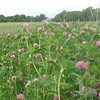White Clover Reseeding
10 reasons to include white clover in your reseeding plan

10 reasons to include white clover in your reseeding plan
10 reasons to include white clover in your reseeding plan
1. White clover is higher in protein than grass alone, typically with a crude protein (CP) content of 27% and every 10% increase in the amount of clover in the sward will improve the CP of first cut silage by 1%. For grazing, as well as lifting CP levels, white clover is highly digestible (typically >75% D Value) and maintains its digestibility throughout the season. This allows for a reduced reliance on bought in protein, making livestock production more efficient, more profitable and reducing environmental impact associated with bought in feed that is often imported.
2. White clover will fix up to 150kg nitrogen per ha per annum dependant on soil and climatic conditions. This can allow for a reduction in artificial N requirements and as a consequence reducing the risk of pollution from volatilisation, run off and leaching. Manufacture and importing of N fertiliser has a very high carbon footprint so reducing your requirement reduced your overall environmental impact associated with your farm business as well as reducing costs.
3. There are a surprising number of bee species in the UK - over 240, 24 of which are bumblebees. Bees are our most important pollinator in the UK, pollinating commercial crops as well as ‘wild’ plants and hedgrerows and the decline is bee population is well known. Bees love white clover so one easy way to help, is to increase the content on the farm.
4. Improved sward resilience - All grass crops need a nitrogen source to both survive and to produce and the inclusion of white clover can provide a lot of resilience to swards, particularly in times of stress. Grass and clover swards are often healthier compared to grass only when disease pressure is high and in wet, late springs or early autumns when travelling to apply artificial N is not possible, clover can provide the nitrogen the crops need to continue growing. White clover also does not suffer from the summer fall in productivity that grass alone does, making it important for mid season production.
5. White clover is higher in some trace elements than grass, particularly Calcium (Ca), Selenium (Se) and Copper (Cu), nutrients that are essential for livestock production.
6. White clover is a perennial product so is invaluable for anyone with a medium to long rotation length or for permanent grassland situation.
7. Easy to introduce - White clover, if not included to the grass mixture when reseeding, can be oversown in numerous different ways. A maximum of 1kg/acre is sufficient and it can be applied with slurry or dung, spun on with fertiliser, hand sown in small areas (perhaps where a patch of weeds has been sprayed out previously), or even fed through sheep by being scattered on a lick bucket or amongst a molassed feed (so it stick to the feed and is consumed). It can be added with stock still in the field, using them to press the seed in with their feet although rolling is advised. Oversowing now after a silage cut or a graze will allow the seed to get sown to the soil and there is still plenty time for gemination and establishment before winter.
8. Flexible options are available with clover. The species is classified by leaf size with very small varieties being best for heavy sheep grazing through to the very largest being best for silage swards. Blend allows those with cutting and grazing requirements, often with both cattle and sheep, a mixture which can adapt to the management applied.
9. White clover supplies around 1,500,000 seeds per kilogram, a little goes a long way. Combined with the multiple ways to apply, often not requiring a separate pass with machinery and the flexible options available, incorporating white clover into the grassland is a very inexpensive method of making some significant improvements. Combined with granulated lime, the combination can make a very economical way of improving difficult upland ground where reseeding is not an option.
10. Improved productivity. Some livestock enterprises are relying on white clover alone, especially on their grazing ground and experiencing no decline in productivity whilst getting the benefit of the reduced environmental impact and reduced costs. When white clover is combined with grass, not only does it produce more dry matter than grass alone, but it also brings more balance to the ration and the improved digestibility improves intakes from grazing livestock and subsequently more meat and milk from the same area.


Buoyant soya prices, carbon reduction efforts and concerns about...
Buoyant soya prices, carbon reduction efforts and concerns about nitrogen management have caused interest in protein-rich forage, such as red clover, to surge, reports agricultural grass experts Barenbrug UK.Focus on ‘home-grown’ sparks surge in red clover